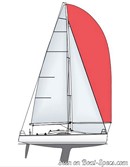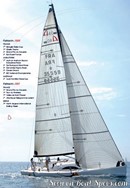A40 RC
Sailboat specifications
The A40 RC is a 39’2” (11.95m) racer-cruiser sailboat designed by Joubert Nivelt Design (France). She was built between 2003 and 2017 by Archambault (France) and BG Race (France).
A40 RC's main features
- Model
- A40 RC
- Hull type
- Monohull
- Category
- Racer-cruiser sailboat
- Sailboat builder
- Sailboat designer
- Country
- France
- Construction
- GRP (glass reinforced polyester):
- Hull: Sandwich PVC fiberglass polyester (vacuum infusion)
- Deck: Sandwich PVC fiberglass polyester - First built hull
- 2003
- Last built hull
- 2017
- Appendages
- Keel : fin without bulb
- Helm
- Twin helm wheels
- Rudder
- Single spade rudder
- Unsinkable
- No
- Trailerable
- No
- EC design categoryiThe CE design category indicates the ability to cope with certain weather conditions (the sailboat is designed for these conditions)
A: Wind < force 9, Waves < 10m
B: Wind < force 8, Waves < 8m
C: Wind < force 6, Waves < 4m
D: Wind < force 4, Waves < 0,5m - A
- Standard public price ex. VAT (indicative only)
- About205 000 €(2017)
A40 RC's main dimensions
- Overall length
- 39’ 4”11.99 m
- Hull length
- 39’ 2”11.95 m
- Waterline length
- 34’ 7”10.54 m
- Beam (width)
- 12’ 4”3.75 m
- Draft
- 8’ 1”2.47 m
- Light displacement (MLC)
- 14330 lb6500 kg
- Ballast weight
- 7716 lb3500 kg
- Ballast type
- Lead
- French customs tonnage
- 13.47 Tx
A40 RC's rig and sails
- Upwind sail area
- 980 ft²91 m²
- Downwind sail area
- 1991 ft²185 m²
- Mainsail area
- 549 ft²51 m²
- Genoa area
- 431 ft²40 m²
- Symmetric spinnaker area
- 1442 ft²134 m²
- IiFore triangle height (from mast foot to fore stay top attachment)
- 53’ 6”16.3 m
- JiFore triangle base (from mast foot to bottom of forestay)
- 15’ 5”4.7 m
- PiMainsail hoist measurement (from tack to head)
- 51’ 2”15.6 m
- EiMainsail foot measurement (from tack to clew)
- 17’ 8”5.41 m
- Rigging type
- Sloop Marconi 9/10
- Mast configuration
- Keel stepped mast
- Rotating spars
- No
- Number of levels of spreaders
- 2
- Spreaders angle
- 20 °
- Spars construction
- Aluminum spars (carbon fiber spars as an option)
- Standing rigging
- Dyform
A40 RC's performances
- Upwind sail area to displacementiThe ratio sail area to displacement is obtained by dividing the sail area by the boat's displaced volume to the power two-thirds.
The ratio sail area to displacement can be used to compare the relative sail plan of different sailboats no matter what their size.
Upwind: under 18 the ratio indicates a cruise oriented sailboat with limited performances especially in light wind, while over 25 it indicates a fast sailboat. - 281 ft²/T26.13 m²/T
- Downwind sail area to displacementiThe ratio sail area to displacement is obtained by dividing the sail area by the boat's displaced volume to the power two-thirds.
The ratio sail area to displacement can be used to compare the relative sail plan of different sailboats no matter what their size. - 572 ft²/T53.12 m²/T
- Displacement-length ratio (DLR)iThe Displacement Length Ratio (DLR) is a figure that points out the boat's weight compared to its waterline length. The DLR is obtained by dividing the boat's displacement in tons by the cube of one one-hundredth of the waterline length (in feet).
The DLR can be used to compare the relative mass of different sailboats no matter what their length:
a DLR less than 180 is indicative of a really light sailboat (race boat made for planning), while a DLR greater than 300 is indicative of a heavy cruising sailboat. - 157
- Ballast ratioiThe Ballast ratio is an indicator of stability; it is obtained by dividing the boat's displacement by the mass of the ballast. Since the stability depends also of the hull shapes and the position of the center of gravity, only the boats with similar ballast arrangements and hull shapes should be compared.
The higher the ballast ratio is, the greater is the stability. - 54 %
- Critical hull speediAs a ship moves in the water, it creates standing waves that oppose its movement. This effect increases dramatically the resistance when the boat reaches a speed-length ratio (speed-length ratio is the ratio between the speed in knots and the square root of the waterline length in feet) of about 1.2 (corresponding to a Froude Number of 0.35) . This very sharp rise in resistance, between speed-length ratio of 1.2 to 1.5, is insurmountable for heavy sailboats and so becomes an apparent barrier. This leads to the concept of "hull speed".
The hull speed is obtained by multiplying the square root of the waterline length (in feet) by 1.34. - 7.88 knots
A40 RC's auxiliary engine
- Engine(s)
- 1 inboard engine
- Engine(s) power
- 29 HP
- Fuel type
- Diesel
- Fuel tank capacity
- 19.8 gal75 liters
A40 RC's accommodations and layout
- Cockpit
- Open aft cockpit
- Cabin(s) (min./max.)
- 2 / 3
- Berth(s) (min./max.)
- 4 / 8
- Head(s)
- 1
- Freshwater tank capacity
- 26.4 gal100 liters
- Holding tank capacity
- 13.2 gal50 liters
- Fridge/ice-box capacity
- 19.8 gal75 liters
- Maximum headroom
- 6’ 7”2 m
- Head headroom
- 5’ 11”1.8 m
A40 RC's saloon
- Maximum headroom
- 6’ 7”2 m
A40 RC's aft cabin
- Maximum headroom
- 5’ 11”1.8 m



Archambault A40 RC sailplan - - 2/14
Picture extracted from the commercial documentation © Archambault
Picture extracted from the commercial documentation © Archambault




Archambault A40 RC sailing - - 5/14
Picture extracted from the commercial documentation © Archambault
Picture extracted from the commercial documentation © Archambault


Archambault A40 RC sailing - - 6/14
Picture extracted from the commercial documentation © Archambault
Picture extracted from the commercial documentation © Archambault


Archambault A40 RC sailing - - 7/14
Picture extracted from the commercial documentation © Archambault
Picture extracted from the commercial documentation © Archambault


Archambault A40 RC sailing - - 8/14
Picture extracted from the commercial documentation © Archambault
Picture extracted from the commercial documentation © Archambault


Archambault A40 RC sailing - - 9/14
Picture extracted from the commercial documentation © Archambault
Picture extracted from the commercial documentation © Archambault


Archambault A40 RC interior and accommodations - - 10/14
Picture extracted from the commercial documentation © Archambault
Picture extracted from the commercial documentation © Archambault


Archambault A40 RC interior and accommodations - - 11/14
Picture extracted from the commercial documentation © Archambault
Picture extracted from the commercial documentation © Archambault


Archambault A40 RC interior and accommodations - - 12/14
Picture extracted from the commercial documentation © Archambault
Picture extracted from the commercial documentation © Archambault


Archambault A40 RC interior and accommodations - - 13/14
Picture extracted from the commercial documentation © Archambault
Picture extracted from the commercial documentation © Archambault


Archambault A40 RC interior and accommodations - - 14/14
Picture extracted from the commercial documentation © Archambault
Picture extracted from the commercial documentation © Archambault
Similar sailboats that may interest you:
Sailboats
First built hull
Hull length
1984
39’ 8”12.09 m
2006
40’ 6”12.35 m
2004
40’12.19 m
2006
35’ 10”10.9 m
2017
40’12.2 m
2006
42’ 7”12.98 m
2006
42’ 7”12.98 m
2019
33’ 11”10.34 m
2000
39’ 8”12.1 m
2018
38’ 7”11.78 m
1984
35’ 8”10.87 m
2006
34’ 8”10.59 m
2014
34’ 8”10.59 m
2014
35’ 5”10.8 m
2012
36’ 5”11.1 m